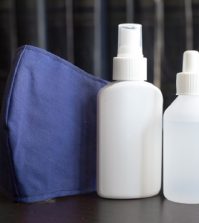- Study Says Most Parents Don’t Use Car Seats In Ride Share Vehicles Like Uber
- This 12-Year-Old Boy Is A Sophomore Aerospace Engineering Major!
- Fire Safety Experts Warn Of Hand Sanitizer Danger After A Mom and Kids Escape House Fire
- Recall Alert: Peaches May Be The Cause Of Salmonella Outbreak, 68 People Ill
- Summer Vacation In The Days Of COVID: Tips To Stay Safe
- How To Safely Grocery Shop During The Coronavirus Pandemic
- Michigan Teen With Vape-Related Illness Undergoes Double Lung Transplant
- Teen Kicks Off Anti-Vaping Campaign From Hospital Bed
- Teenager Receives Life Sentence For Strangling Sister To Death Over A Wi-Fi Password
- Toddler Falls To Death From 11th Deck of Cruise Ship
It’s Possible To Safely Fit 4 Car Seats in the Backseat of Your Car!


Mom, Danielle Lloyd got creative on a whole new level when she found a way to squeeze all four of her children into the backseat of her car.
The model, whose fourth child is on the way, had to make the choice between buying a new car or getting all her little ones to fit safely and comfortably in the backseat of her current car.
She posted a photo to Instagram on Aug. 17 of how she customized a set of four car seats to fit her needs.
In her caption, she wrote: “Absolutely love our new personalized car chair made for our four boys making our three seats into four.” She also “fully recommended” MultiMac, who makes custom car seats that accommodate three to four kids.
Keep in mind – parents should always consult the latest car seat safety recommendations based on their child’s age and weight, as they tend to change often:
Here are some tips to help you properly install a car seat.
Read All About Car Seat Installation
The first and most important step to installing your child’s car seat correctly is to read the manual. There you will find almost everything you need to know: height and weight guidelines, how to secure the seat and how to position your little one.
“You always want to replicate the installation just like the manufacturer does when crash testing the seat,” says Allana Pinkerton, a child passenger safety technician at Diono, a car seat manufacturer. “While you might think you are adding more protection, you might be doing more harm than good.”
Should You Use the LATCH System or a Seat Belt?
There are two main ways to make your child’s car seat stay put — the LATCH system, which stands for Lower Anchors and Tethers for Children, and the standard seat belt. Which is better? It may depend on your child, the car seat and your car itself. “They both crash test equally safe,” explains Amie Durocher, a certified CPS technician since 2004 and the creative director at Safe Ride 4 Kids. “The seat belt has no weight limits, though the LATCH system does. But the real answer is: Whichever you can use correctly every time in your car with your car seat.”
Common Installation Problems and Solutions
Pinkerton says that the most common car seat installation problems CPS technicians see are loose seats, seat belts routing the wrong path and the use of both the LATCH system and seat belt together. Here’s how to identify and avoid these problems.
- Loose Installation
“After carefully following the instruction manual, a one-handed tug on the belt path should not move the car seat or base of the infant seat more than one inch side-to-side or front-to-back,” says Pinkerton. Durocher adds that the small amount of wiggle room is fine, as “the car seat is designed to have a little bit of movement for energy absorption during a crash.” - Loose Harness Straps
To check strap tightness, try to pinch the strap with your thumb and forefinger vertically where it hits the shoulders.”If you can pinch the material together, it is too loose and needs to be tightened,” Durocher says. - Improperly Positioned Harness Straps
Even if the seat is secure, having the straps in the wrong position could put your child in danger. “Straps should be positioned at or below the child’s shoulder for rear-facing seats, and at or above for forward-facing seats,” says Durocher. The chest clip should be at armpit level. Whether rear-facing or front-facing, check that the harness straps are properly routed through the hard plastic of the safety seat, and that they always lie flat. If not, Durocher says, “Reroute the straps, making sure to keep them free from twists.” - Doubling Up
Don’t use both LATCH and the seat belt together to install a car seat — only one or the other is needed, according to the Department of Health.
Car Seat Installation Help
If you just can’t figure out the installation, or aren’t sure you have it right, fear not: There are certified CPS technicians in every state, and thousands of free car seat inspection events take place each year. There, trained experts will teach you everything you need to know to make sure your car seat is installed and used correctly. “If your child is available,” says Pinkerton, “bring them along, as this is helpful in setting the harnesses at the proper height and showing you how to adjust everything on the car seat.” If your baby hasn’t yet arrived, ask the technician to use a doll as an example.
Although a first-time car seat installation could take an hour or more, doing it correctly will bring you peace of mind. In the event of an accident, you will be grateful for every second you took to help keep your child as safe as possible.

WARNING: BEWARE OF HOMEMADE SLIME
We came across an interesting article about homemade slime. It’s a popular thing with the kids right now, so we thought we should share.
The post starts off by saying:
“I’m writing this to let you know our experience with homemade slime. I am not a doctor or a scientist or a chemist. I just don’t want what happened to my daughter to happen to anyone else…
If you have elementary age kids, you are probably familiar with the current slime obsession. My daughter and her friends became obsessed with it a few months ago and couldn’t get enough of it. So much so that they decided they would start making it themselves at home, a simple endeavor providing you have the right ingredients.”

burn from slime
While we know that homemade slime basically consists of:
Borax
White Glue
Water
Shaving Cream
Food Coloring (optional)
You may find a few variations of the above recipe, but these ingredients are more or less of what is used to make it.
The Mom said that her 12-year-old child got sick, which they initially thought was the same basic cold. The symptoms were the same: cough, sore throat, stuffy nose but she was also complaining about headaches and general achiness.
Assuming that her symptoms would be relieved in a few days, they didn’t pay it too much attention.
Unfortunately, they didn’t go away and weeks later, the family was left wondering what on earth was going on! The Doctor found nothing at first – other than your basic cold symptoms, there wasn’t anything wrong with her on the surface.
But the Mom thought there was something more than what meets the eye…
Her husband was actually the one who connected the dots. He said one night, “Do you think it could have something to do with the slime she’s been making?”
She said it was like a lightbulb went off. From that moment, the family banned her from making, holding, touching or even looking at that slime.
The very next day, her headache went away and her throat didn’t hurt anymore. She still had some congestion, but was not coughing. Two days later, the congestion started going away and she was breathing better and talking better.
The Mom started to investigate a little more about what her child was getting into and what she found out was disturbing. She quotes:
BORAX – FROM THE WEBSITE, CQ CONCEPTS:
Boric acid, sodium borate, and sodium perborate are estimated to have a fatal dose from 0.1 to 0.5g/kg. These substances are toxic to all cells, and have a slow excretion rate through the kidneys. Kidney toxicity is the greatest, with liver fatty degeneration, cerebral edema, and gastroenteritis. Boric acid solutions used as an eye wash or on abraded skin are known to be especially toxic to infants, especially after repeated use due to its slow elimination rate.
GLUE – FROM THE WEBSITE, MEDILINE PLUS:
Symptoms of breathing in (“sniffing”) glue fumes may include:
– Anxiety
– Convulsions (from breathing in large amounts)
– Drunk, dazed, or dizzy appearance
– Excitability
– Headache
– Irritability
– Loss of appetite
– Nausea
– Red, runny nose
– Low oxygen level in the blood and organs (respiratory failure)
– Stupor
– Seizures
– Coma

SHAVING CREAM – FROM THE WEBSITE, HOW STUFF WORKS:
Propolene glycol is a humectant like glycerin, but unlike glycerin, it’s more frequently found in antifreeze and brake fluid. Triethanolamine, better known as TEA, is an emulsifying agent, meaning it helps keep the oil and water from separating.
It’s also a very controversial ingredient in the cosmetic industry because not only is it a skin irritant, but many formulas containing TEA are found to be contaminated with nitrosamines, which are linked to cancer. Sodium lauryl sulphate (SLS) and sodium laureth sulphate (SLES) are two more controversial skincare ingredients. These make a great lather, but they also have a number of health implications. Lauryl mimics estrogen, which is especially problematic for women, and laureth often hosts a known carcinogen called dioxane.
How scary!!!
Toxic…. Respiratory Failure… Seizures…. Cancer…. Coma…..
I doubt any parent would want to put their kids at risk of any of the above!
In conclusion, the Mom said:
“Can I ever be 100% sure that the homemade slime ingredients were causing my daughter’s illness? Probably not. But… one thing I’ve learned in 17 years of parenting is never to ignore your gut instinct… and ours said that making slime was hurting our kid.
All I can say is please be informed. What seemed so innocent turned out to be full of ingredients that are deadly. So even though these ingredients might have really had nothing to do with Lauryn being sick, the fact remains that these ingredients are dangerous and have no business being in the hands of children. Or anyone.”
Have your kids had an experience with similar symptoms?









0 comments